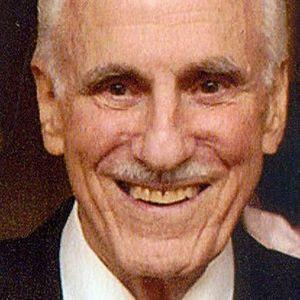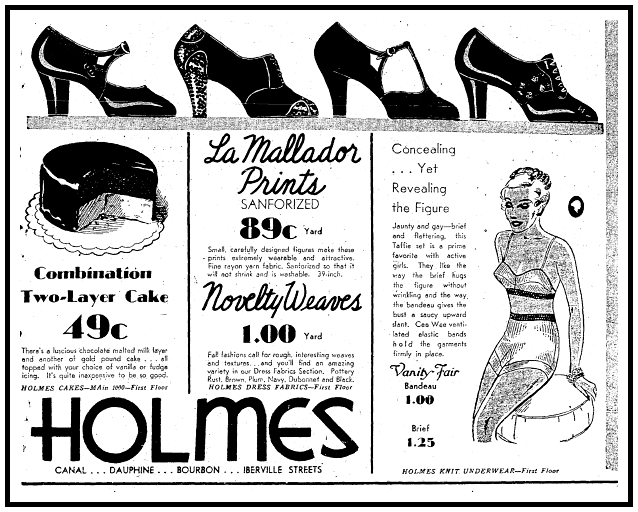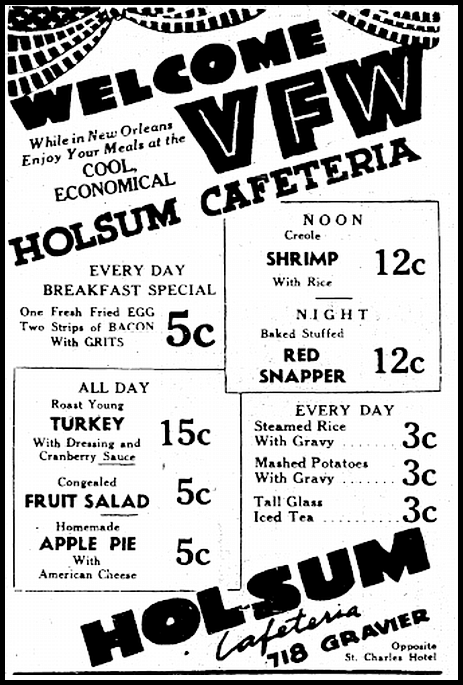|
Today in New Orleans History |
|
|
September 18


 To receive an update for each day in New Orleans history,
join our facebook page - Today in New
Orleans History.
Harry J. Batt, Jr., a prominent local businessman and family
man, died Sunday, September 18, 2011. He was 85 years of age. A life-long resident of the New Orleans area, Mr. Batt graduated from
Riverside Military Academy in Hollywood, Florida, in 1941, and attended Tulane University, graduating with a B.A. degree in
1946. After securing his B.A. degree, he commenced architectural and design studies at the Chicago Institute of Design. While
an architectural student, he was called upon by his father, Harry Batt, Sr., to assist in operating a local business, Pontchartrain Beach Amusement Park,
on the lakefront in New Orleans. Over a period of many years, he worked his way up from stock/merchandise clerk to the position
of President of Playland Amusements Incorporated, the operator of Pontchartrain Beach Amusement Park. Although at one point
he hoped to have a career in architecture, he abandoned that interest when he began working at the amusement park and when
he decided "to make a living out of fun". He learned the amusement park business, along with his brother, John Batt, from their father.
His father, Harry Batt, Sr., retired in
1970, andHarry Batt, Jr., and his brother, John Batt, served as President, and Vice President,
respectively, until the lakefront park closed, in 1983. Pontchartrain Beach was an amusement park located on the shores of
Lake Pontchartrain, which operated for 54 years. Mr. Batt managed the park, along with his brother John, from the 1960's until its closure
in 1983. Pontchartrain Beach included a beach shore, amusement rides (including a thrilling rollercoaster known to New Orleanians
as The Zephyr), and concession stands. The park featured live music concerts, including performances by many local musicians. Generations
of New Orleanians have fond memories of the amusement park's thrills. A landmark of the park's asphalt midway was the giant
clown head, whose mouth was big enough to accommodate multiple kids. Mr. Batt enjoyed
walking the midway and watching the kids' reactions. The park's wooden rollercoaster, the Zephyr, was, for many years, considered
to be one of the nation's finest. Contrary to its name, it was not a gentle breeze, as it rocketed kids to 60 miles per hour
on a sinuous track. The
amusement park offered a variety of family entertainment. Free shows started every night at 9 p.m. Animal acts, circus performers,
and marriage ceremonies conducted on a tightrope entertained guests on steamy, summer nights. Tightrope walkers and circus
acts were succeeded by big name acts like the singers Rudy Valle, Fabian, and Elvis Presley. Elvis, who was in his early days
as a performer, lost top billing to an animal act. Mr. Batt was very active in business organizations
and in the fabric of the local community – he was a president of the International Association of Amusement Parks and
Attractions; he served on the Board of various metropolitan banks; he was active in the Hermes Carnival Organization; he served
as a consultant for the Seattle World's Fair; he provided advice regarding Disney's expansion into Orlando, Florida; and he
served as President of Rotary. Mr. Batt, along with his brother, started the "Storyland" amusement park in City Park, which included
a miniature train, carousel, and other attractions. Storyland operated under the oaks in City Park for many decades. Upon
the conclusion of this City Park amusement venture, he and his family arranged for the unique European carousel to be fully
restored so that it could be given as a donation to New Orleans, the city he loved, for future generations of kids. In
his later years, after he retired from the amusement business, Mr. Batt became
a fine amateur artist. Painting became more than a hobby and family and friends consistently requested that he produce works
for them. His passion for painting caused him to study at many local art schools. In his retirement years he loved to paint
for hours, have dinner at the end of the day, and enjoy a good glass of wine with his loved ones. "He
married the woman of his dreams and loved her until the day he died. He built a family and watched it grow and prosper. His business
brought joy to thousands. In his retirement, his brilliance turned to art and he left a legacy to his loved ones. He was an entrepreneur, a world
traveler, a connoisseur of food and drink, a top-notch conversationalist and a devoted individualist".  To receive an update for each day in New Orleans
history, join our facebook page
- Today in New Orleans History
The
U.S. Army Corps of Engineers performed a detailed assessment of about 350 miles (560 km)
of hurricane levee and developed a comprehensive, prioritized plan to repair it and the pumping stations that support
New Orleans and surrounding areas. "The system in its present condition does not ensure
that the city will be protected from flooding resulting from storms or hurricanes," stressed
Col. Duane Gapinski, Task Force Unwatering commander. Gapinski said that residents could be
placing their lives and property at risk by re-entering flooded areas until additional emergency
levee repairs are made. State and local leaders were informed as assessments are being completed and repairs are
made. Recovery of New Orleans was seen as a three-phase process:
first and most immediate, to unwater the city and assess flood protection. Second, to provide an interim
level of protection to get the city through hurricane season and later high water, and over
the long-term, to return the system to pre-hurricane conditions. This will take a tremendous
amount of study, research, funding and construction. Gert Town Building The American Chicle Company Building, located at 8311 Fig St in the Gert Town,
was added to the National Register of Historic Places on September 18, 1998. Built as a branch factory of the company,
it opened for production in 1911. After it closed, the building housed a box factory and an automotive parts warehouse.
Flooded in the aftermath of Hurricane Katrina, it sat vacant until it was refurbished as an office building in 2008-2009,
the building now houses the headquarters of Landis Construction Company.
Blue Room Conductor Born on May 29, 1909 in Newark, New Jersy, Dick Stabile joined Ben Bernie's orchestra in 1928. In 1935 he started his own ensemble, recording with
vocalists such as Bunny Berigan, Paula Kelly, Burt Shaw, and Gracie Barrie,
who he would go on to marry. During this he recorded for the labels Decca, Bluebird, ARC,
and Vocalion/Okeh. During World War II Stabile led a band while serving in the Coast Guard;
Gracie Barrie led his ensemble in his absence. After the war he moved to Los Angeles where he began working with Dean Martin
and Jerry Lewis from 1949 until his death. He was the leader of the orchestra on many of Martin's popular recordings.
Additionally, he worked with Jimmy Dorsey and Vincent Lopez.
His band worked often in hotels in New York City and was chosen
to play at the New York World's Fair in 1959–60. After spending the 1960s leading dance bands at
Los Angeles ballrooms, Stabile took a job at the Hotel Roosevelt in New Orleans, where he worked from the middle of the
1970s until his death on September 18, 1980 from a heart attack.
Veterans Convention in New Orleans September 18, 1935 _____ New Orleans ladies may have been shopping at Holmes on Wednesday, September 18, 1935
to pick up Sanforized sewing fabric for 89 cents per yard, a 49 cent layer cake, or a Vanity Fair bandeau (brassiere) for
just a dollar -- all on the first floor. But when they stepped outside the streets were filled with military veterans
in town for the annual Veterans of Foreign Wars convention. Some vets might have stepped out of the St. Charles Hotel
and crossed Gravier Street for a 5 cent breakfast at Holsum Cafeteria (or a 12 cent shrimp Creole lunch or a 12 cent
baked and stuffed red snapper dinner). The evening before, the vets put on a grand parade involving thousands of marchers, tanks, blasting
canons, locomotives, marching Missouri mules, boy scouts, and floats which formed a five-mile procession. . The parade
began at Canal and Claiborne, wound down St. Charles, stopped at City Hall (Gallier Hall where dignitaries from the U.S.,
Japan, and Cuba filled viewing stands), proceeded to South Street, then headed back to Canal Street before turning on to North
Rampart and ending at the Municipal Auditorium. All states were represented, some with large delegations but the show stopper was the group
of ladies from the Des Moines auxiliary who wore electrified letters on their chests which flashed the name of their city,
state, and post number. Amid the gaiety, post commander Henry Kranz from Minnesota's Kenabec County Post 2965 "dropped
dead" (according to the Times-Picayune) as he marched on the 400 block of Camp Street . He was 60 years old and a veteran
of the Spanish-American War.
Theodore Jourdan Debuts Born
in New Orleans on September 5, 1895, Theodore Charles Jourdan made his Major
League Baseball debut for the Chicago White Sox on September 18, 1916. He was a first baseman over parts of four
seasons (1916–1918, 1920) with Chicago. He complied a career batting average of .214 in
196 at-bats, with 11 RBIs. He ended his career in the majors on October 3, 1920 with
the White Sox with whom he played with for World Series championship in 1917 He died in New
Orleans, Louisiana at the age of 66 on September 23, 1961. Publisher
& Socialite Born
in New Orleans on September 18, 1914, Miriam Florence Folline Peacock Squier Leslie Wilde earned fame as the editor of her third
husband's Frank Leslie's Lady's Magazine. She won fortune
as the heir to his publishing business which she saved from huge depts
through her work there. She was the descendant of a noble Huguenot family and after a trip to France, in 1901, she claimed
the title Baroness de Bazus. Her first marriage, on March 25, 1854, to David Charles Peacock was annulled two years later.
She then married anthropologist Ephraim Squier and became involved with Frank Leslie's
Lady's Magazine when its editor fell ill (probably in the late 1860s) and she volunteered to fill in while the ill editor
still received the salary. After the editor died she took on the job -- the November 18, 1871, issue noted that it was
“conducted by Miriam F. Squier.” On May 31, 1873 she divorced Squier to marry Leslie. During their honeymoon, they met poet and author Joaquin Miller and she began an affair with him -- the main
character in his book The One Fair Woman was modeled after her. The Leslie's lived lavishly,
having a summer home in Saratoga Springs, New York, where they entertained notables,
and she was a leader in society. In 1877, they took a
costly train trip with fellow socialtes from New York, San Francisco, and other big cities . She wrote her recollections
of this trip in her book From Gotham to the Golden Gate. The expense of the trip and an economic depression left
Leslie's business badly in debt. When he died in 1880, the debts amounted to $300,000, and his will was contested. Miriam
took over the business and made it succssful. She legally changed her name to Frank Leslie in June 1881.
She later reorganized the business and became its president. The circulation of the Popular Monthly increased 200,000
in four months under her management.. While
abroad in 1891, Miriam Leslie married Willie Wilde, the older brother of Oscar Wilde but divorced him two years later.
In 1902 she sold out all her publishing interests. Miriam died on June 5, 1836. In her her will she made Carrie Chapman
Catt residuary legatee with the expectation that most of her fortune would be devoted to
women's suffrage. Her remains are buried in Woodlawn Cemetery in the Bronx.
The Leslie empire began with Frank Leslie's
Ladies' Gazette of Fashion and Fancy Needlework, with good woodcuts by Leslie & Hooper, a partnership which dissolved
in 1854. It included The New York Journal, Frank
Leslie's Illustrated Newspaper (1855 -- also called Leslie's Weekly), The Boy's and Girl's Weekly,
and The Budget of Fun. Leonard Joseph Yochim Debuts with the Pirates September 18, 1951 ______ Born on October 16, 1928 in New Orleans, Lenny Yochim made
his professional baseball debut with the Pittsburgh Pirates on this day in 1951. He played in parts of
two seasons for the Pirates in 1951 and 1954, and later served in the organization for almost four decades. A left-handed
screwball specialist, he threw a good curve ball as well, but a sore arm limited him to pitch
in only 28.1 innings. He pitched in two games in 1951 and ten in 1954, ending his major league
career with a 1-2 record and a 7.62 ERA in 12 games (three as a starter). His professional career highlight came on
December 8, 1955, when he became the first pitcher to throw a no-hitter in a professional game
in Venezuela while pitching for the Caracas Lions club. Helped by catcher Earl Battey, Yochim
accomplished the feat in the Caracas 3–0 victory over Magallanes. Ramón Monzant
was credited with the loss. Following his playing career, Yochim rejoined the Pittsburgh Pirates organization in 1966 to become a member of their baseball operations department. He served as an area scout, national crosschecker and major-league scout for the Pirates before moving into the front office in 1994. Yochim also worked as a senior adviser for player personnel from 1994 through 2004, when he decided not to return for another season. He died in New Orleans on May 11, 2013.
|
|
|

To receive an update for each day in New Orleans history,
join our facebook page - Today in New
Orleans History.
Analytics |




